Why Hydraulic Body Lifts Are Essential for Modern Death Care
Hydraulic body lift systems are specialized lifting devices that use pressurized fluid to safely transfer human remains between surfaces in funeral homes, mortuaries, and crematories. These lifts can handle up to 1,000 pounds and feature adjustable straps, multiple swivel casters, and hand-operated hydraulic pumps for smooth, controlled movement.
Key Features:
- Weight capacity: Up to 1,000 lbs
- Operation: Hand/foot lever hydraulic system
- Mobility: Nine 4" swivel casters for easy maneuvering
- Straps: Four adjustable washable nylon web straps
- Warranty: Typically 1-year coverage
- Construction: Heavy-duty, often USA-made
As one industry expert notes: "Moving a body from the embalming table to the dressing table and then to the casket requires additional assistance." This simple truth highlights a critical challenge facing funeral professionals daily.
Manual lifting puts staff at serious risk. Back injuries, muscle strains, and repetitive motion injuries are common when funeral workers attempt to lift and transfer remains without proper equipment. Beyond staff safety, there's an equally important concern about maintaining dignity for the deceased during transfers.
Hydraulic body lifts solve both problems. They eliminate the physical strain on funeral staff while ensuring smooth, respectful handling of remains. Unlike electric alternatives that depend on batteries or power outlets, hydraulic systems work reliably anywhere using simple hand or foot lever operation.
These lifts have become standard equipment in modern funeral homes, crematories, and medical facilities. They represent a smart investment in both worker safety and operational efficiency - often paying for themselves through reduced injury costs and improved workflow.
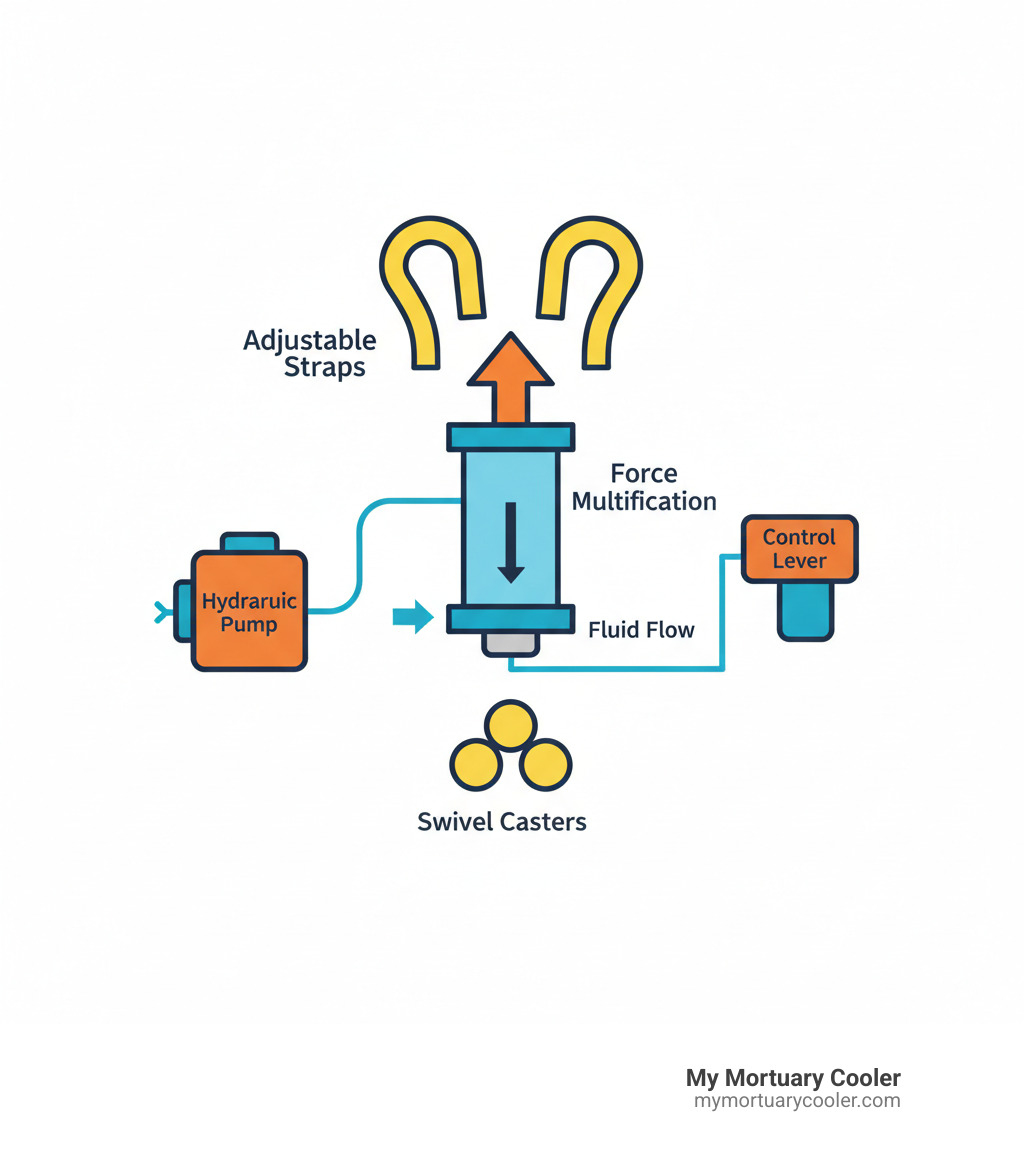
How a Hydraulic Body Lift Works and Its Key Components
The magic behind every hydraulic body lift starts with a simple but powerful physics principle called Pascal's Law. When you apply pressure to fluid trapped in a closed system, that pressure spreads equally throughout the entire system. This means a small amount of force on your part can create much larger lifting power on the other end.
Think of it like this: when you pump the hand lever on a hydraulic lift, you're pushing fluid through the system. That fluid then pushes against a much larger piston, multiplying your effort many times over. It's the same principle that lets a small hydraulic jack lift an entire car.
This force multiplication through fluid mechanics is what makes it possible for one person to safely lift and move remains that would otherwise require multiple staff members. The system transforms your gentle pumping motion into smooth, controlled lifting power.
For a deeper understanding of these fascinating systems, check out our Beginners Guide to Hydraulic Lifts: How They Work and Their Uses.
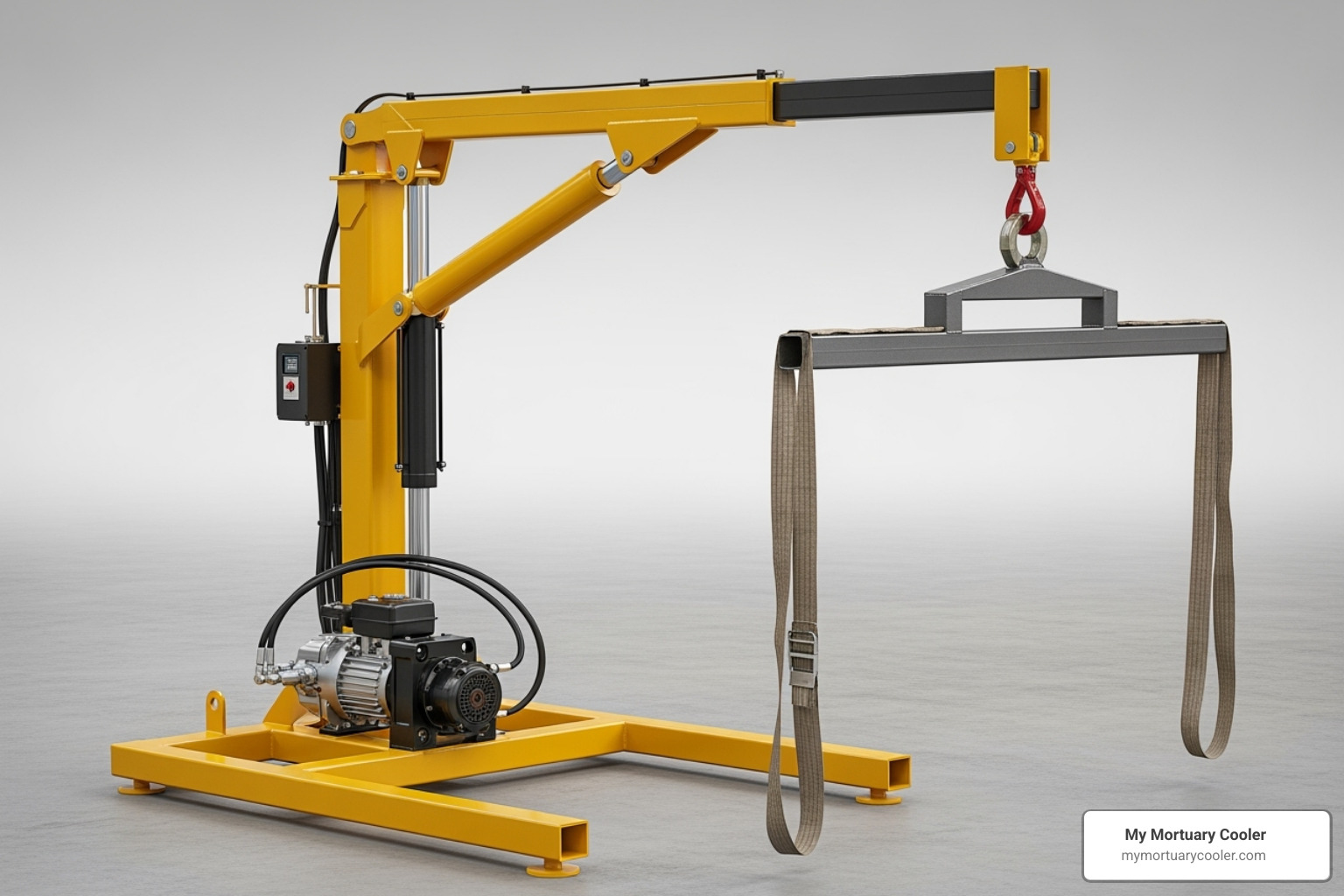
The Power of a Hydraulic System
Let's walk through what happens when you operate a hydraulic body lift. The process starts with the hydraulic pump, which you activate using either a hand lever or foot pedal. This pump draws hydraulic fluid from a reservoir and forces it under pressure into the system.
The hydraulic fluid itself is specially designed to be incompressible, usually an oil-based formula. This property is crucial because it allows the fluid to transfer force efficiently without losing power along the way.
When the pressurized fluid reaches the cylinder and piston, the real magic happens. The fluid pushes against the piston, which connects directly to the lift's boom. This creates the smooth upward motion that raises the remains with minimal effort on your part.
One of the best features of hydraulic systems is their controlled lifting and lowering capability. A release valve lets you control exactly how fast the lift descends by allowing fluid to return slowly to the reservoir. This ensures dignified, gentle handling during every transfer.
Essential Components of a Mortuary Lift
Beyond the hydraulic engine, a quality hydraulic body lift includes several key components designed specifically for mortuary use. The heavy-duty frame forms the foundation, typically built from robust steel that can handle daily use and significant weight loads without compromising stability.
The adjustable body carriage provides the platform where remains rest during transfer. These carriages adjust to accommodate different body sizes while maintaining secure support throughout the lifting process.
Washable nylon web straps serve as the crucial interface with the deceased. Quality lifts feature four 2-inch adjustable straps that are both strong and easy to sanitize. The straps that go under the body often attach to a wand system, making positioning much easier without disturbing the remains.
Mobility comes from the swivel casters at the base. Professional-grade lifts typically feature nine 4-inch swivel casters, providing exceptional maneuverability even in tight spaces. This allows smooth navigation through doorways and around furniture with heavy loads.
Safety features include reliable locking mechanisms on the casters. These prevent unwanted movement during transfers or preparation work, ensuring the lift stays exactly where you position it.
When choosing a lift, the hydraulic pump quality makes all the difference in performance and longevity. Our The Definitive Guide to Choosing a Hydraulic Lift Pump covers everything you need to know about selecting the right pump for your needs.
Primary Applications and Core Benefits
When you're managing a funeral home or mortuary, every decision comes down to three things: keeping your staff safe, treating families with dignity, and running an efficient operation. A hydraulic body lift delivers on all three fronts in ways that might surprise you.
Think about it - how many times a day do your staff members lift and transfer remains? Each manual lift puts tremendous strain on their backs, shoulders, and knees. Over time, this leads to costly workers' compensation claims and staff turnover. But beyond the financial impact, there's something more important at stake: the respectful handling of the deceased.
Hydraulic body lifts transform these challenging moments into smooth, controlled transfers that honor both the deceased and protect your team. The benefits extend far beyond just avoiding injury - they improve your entire workflow and help you maintain OSHA compliance standards.
For more insights on how these lifts improve daily operations, check out our detailed analysis: Mortuary Lifts: Enhancing Funeral Home Efficiency - American Mortuary.
Where Are Hydraulic Body Lifts Used?
You'll find hydraulic body lifts working hard in facilities where dignity and safety matter most. Funeral homes rely on them for transfers between embalming tables, dressing areas, and caskets - especially when handling bariatric cases that would otherwise require multiple staff members.
Mortuaries and crematories use these lifts for moving remains from receiving areas to refrigeration units and preparation areas. The robust lifting capacity proves invaluable when dealing with both bodies and heavier caskets heading to cremation chambers.
Medical facilities have finded their value too, particularly for patient transfers involving bariatric cases. Anatomy labs and educational institutions appreciate the precision and control these lifts provide during cadaver positioning for study and dissection.
What makes these applications successful is the lift's ability to work anywhere in your facility. No need to worry about power outlets or battery levels - just pump the handle and you're ready to go.
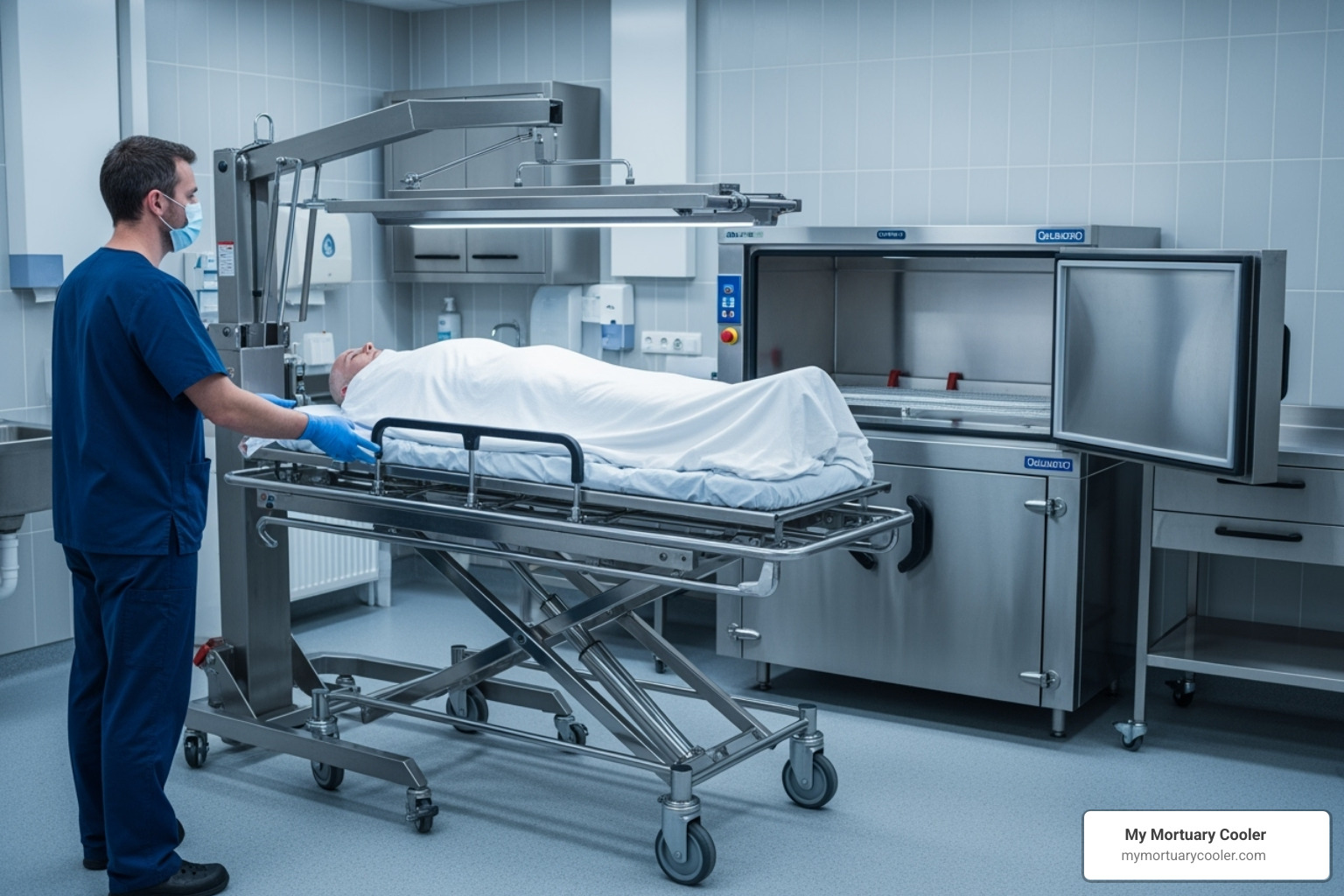
Key Advantages Over Manual and Electric Lifts
Here's where hydraulic body lifts really shine compared to other options. The superior lifting power means you can handle over 1,000 pounds with ease - something that's simply impossible with manual lifting and often challenging for electric alternatives.
The smooth, jerk-free motion that hydraulic systems provide isn't just about comfort - it's about maintaining dignity during transfers. The controlled flow of hydraulic fluid ensures every movement is stable and respectful.
Reliability is another game-changer. While electric lifts can fail when batteries die or circuits malfunction, a well-maintained hydraulic system just keeps working. There's no reliance on batteries or power outlets, which means you can use your lift anywhere in the facility, even during power outages.
From a business perspective, the cost-effectiveness is hard to ignore. You won't face ongoing battery replacement costs or complex electronic repairs. The simple mechanical design typically means lower maintenance expenses over the lift's lifetime.
If you're curious about how hydraulic systems compare to battery-powered alternatives, our comprehensive guide breaks down all the details: A Practical Guide to Comparing Battery Powered Lifts.
Specifications of a Heavy-Duty Hydraulic Body Lift
When you're investing in a hydraulic body lift, you're not just buying a piece of equipment – you're choosing a partner that will handle your most challenging cases with grace and reliability. These lifts are engineered to be the backbone of modern funeral operations, designed to perform flawlessly day after day, year after year.
What sets a truly heavy-duty lift apart? It starts with understanding that bariatric cases are becoming increasingly common, and your equipment needs to handle these situations safely and efficiently. That's why quality hydraulic lifts are built with exceptional strength and durability in mind.
The best lifts are built to last with superior American manufacturing standards. When you see "Made in USA" on mortuary equipment, it's more than a label – it's a promise of quality craftsmanship and materials that can withstand the demanding environment of funeral service.
For more insights into how durable equipment contributes to a safer working environment, explore our article: Maximize Safety with American Mortuary's Durable Crematory and Mortuary Lift Solutions.
Weight Capacity and Handling Capability
The heart of any hydraulic body lift is its ability to handle substantial weight effortlessly. Professional-grade lifts can easily handle over 1000 lbs, making them indispensable for bariatric cases that would otherwise require multiple staff members and create significant injury risks.
But raw lifting power is only part of the equation. Easy maneuvering is equally critical in the tight spaces of funeral homes and mortuaries. The secret lies in the caster system – nine 4-inch swivel casters provide exceptional mobility and stability. This might seem like overkill, but those extra casters make all the difference when you're navigating narrow hallways or positioning the lift precisely next to an embalming table.
Navigating doorways becomes effortless with this superior mobility system. You can smoothly guide a fully loaded lift through standard doorways without the awkward maneuvering required with less sophisticated equipment. This seamless movement prevents bottlenecks in your workflow and reduces the physical strain on operators.
Perhaps most importantly, this combination of power and maneuverability enables one-person operation in most situations. A single funeral professional can safely transfer remains without assistance, freeing up other staff members for different tasks and eliminating the coordination challenges of team lifting.
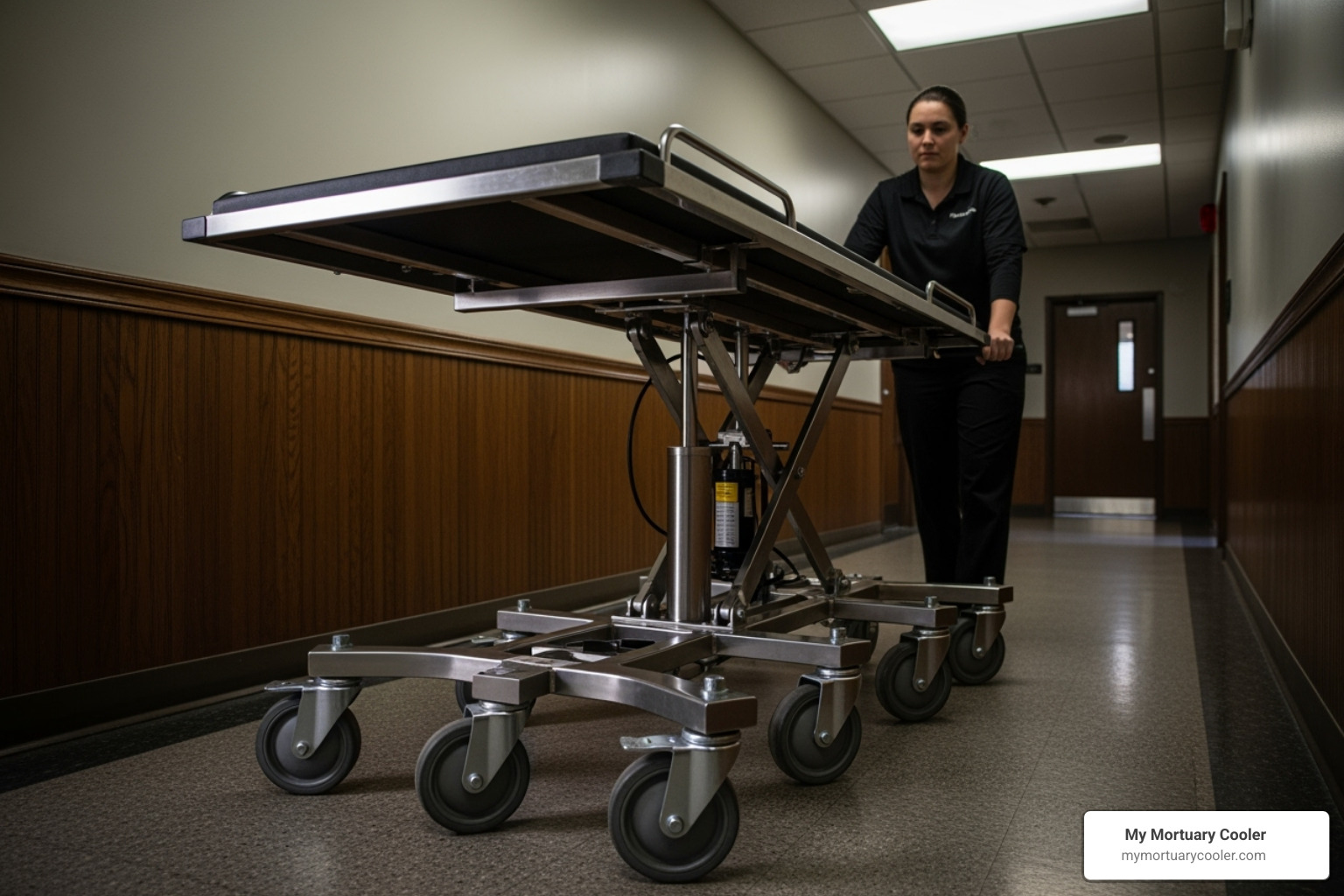
Safety Features, Lifespan, and Warranty
Safety isn't an afterthought in quality hydraulic body lift design – it's woven into every component. The durable strap system features four 2-inch adjustable washable nylon web straps that provide secure, dignified support. These straps are engineered for strength while remaining easy to clean and maintain between uses.
Locking casters provide essential stability once you've positioned the lift. With a simple engagement, you can secure the lift in place, preventing any unwanted movement during transfers or preparation work. This feature gives operators confidence and ensures the safety of both staff and the deceased.
The controlled descent capability of hydraulic systems is particularly important in funeral service. Unlike mechanical lifts that might drop suddenly, hydraulic systems allow for smooth, gradual lowering that maintains dignity throughout the process. This precision control is one reason why hydraulic systems have become the preferred choice in professional settings.
Heavy-duty construction means these lifts are built to handle the rigors of daily funeral home operations. Quality materials and robust engineering ensure reliable performance even with frequent use. The investment in a well-built lift pays dividends through years of dependable service.
Most professional-grade hydraulic lifts come backed by a one-year warranty, demonstrating the manufacturer's confidence in their construction and performance. This warranty coverage provides peace of mind and protection for your investment, ensuring that any manufacturing defects or premature failures are addressed promptly.
Frequently Asked Questions about Body Lifts
The term "body lift" can spark confusion, especially when you're researching equipment for your funeral home. We get calls from folks who've been searching online and aren't sure they're looking at the right type of equipment. When we talk about hydraulic body lift systems in mortuary services, we're referring to specialized equipment for respectfully handling human remains - not truck modifications or other lifting devices.
Let's clear up some of the most common questions we hear from funeral professionals.
What's the difference between a mortuary body lift and an automotive body lift?
This question comes up more often than you might think, especially when people are doing online research. The confusion is understandable since both use the term "body lift," but they serve completely different purposes.
Mortuary hydraulic body lifts are designed for the vertical lifting and horizontal transfer of human remains within funeral homes, mortuaries, and crematories. Our focus is always on staff safety, maintaining dignity for the deceased, and improving operational efficiency. These lifts use hydraulic power to smoothly raise and lower a body carriage, then roll on casters for easy positioning.
Automotive body lifts, on the other hand, are truck modifications that create space between a vehicle's body and its frame. Truck enthusiasts use spacers between body mounts and the chassis to fit larger tires or achieve a taller appearance. While some automotive shops might use a hydraulic lift during installation, the "body lift" refers to the vehicle modification itself, not the lifting equipment.
If you're curious about automotive applications, resources like Body Lift Kits for Trucks - The Ultimate Guide or community discussions on Nissan4wheelers cover those topics in detail.
How does a hydraulic body lift differ from a casket lift?
While both pieces of equipment serve funeral homes, they're designed for different primary functions, though some overlap exists. Understanding these differences helps you choose the right equipment for your specific needs.
A hydraulic body lift primarily handles human remains directly, using specialized adjustable straps that secure the body safely and respectfully. The straps are carefully positioned under the body, often with wand assistance to make placement easier without disturbing the deceased.
A casket lift focuses on moving caskets - whether they contain remains or are empty for display or preparation. These lifts typically feature flat platforms or roller systems designed to support the rigid structure of a casket, sometimes with side rails for additional security.
Both types offer excellent maneuverability with caster systems, but body lifts often have a narrower profile optimized for direct body handling in tighter spaces. Casket lifts tend to be broader and more robust to support a casket's full footprint and weight.
Some lifts bridge both worlds. Heavy-duty units like our MOBI Hydraulic Body & Casket Lift are engineered for dual functionality, handling up to 1000 lbs whether you're transferring remains with straps or moving caskets on the platform surface.
What features indicate a high-quality, durable lift?
Choosing a hydraulic body lift represents a significant investment in your facility's safety and efficiency. After years of working with funeral professionals, we've learned which features truly matter for long-term reliability and performance.
High weight capacity stands as the first indicator of quality construction. Look for lifts that handle at least 1000 lbs comfortably. This capacity isn't just about bariatric cases - it signals robust engineering throughout the entire unit that will serve you reliably for years.
USA-made construction often indicates superior craftsmanship and quality control. American manufacturing typically adheres to higher standards for materials and assembly, contributing to greater durability and longevity. We're proud to offer equipment that's "Made In USA" because we've seen the difference in build quality.
Positive user testimonials from other funeral professionals provide invaluable insights beyond product specifications. Real-world experiences reveal how equipment performs under daily use, helping you understand reliability and long-term satisfaction.
Superior caster systems make a bigger difference than many people realize. Our lifts feature nine 4-inch swivel casters, which indicates both superior maneuverability and better weight distribution. More high-quality casters reduce wear and tear while making the lift easier to steer through doorways and tight spaces.
Comprehensive warranty coverage demonstrates a manufacturer's confidence in their product. Our one-year warranty provides peace of mind and shows we stand behind our equipment's durability and performance.
Quality strap systems ensure both security and hygiene. Look for adjustable, easily washable nylon web straps that maintain their strength over time. Robust frame materials like heavy-gauge steel or marine-grade aluminum alloy provide the foundation for years of reliable service.
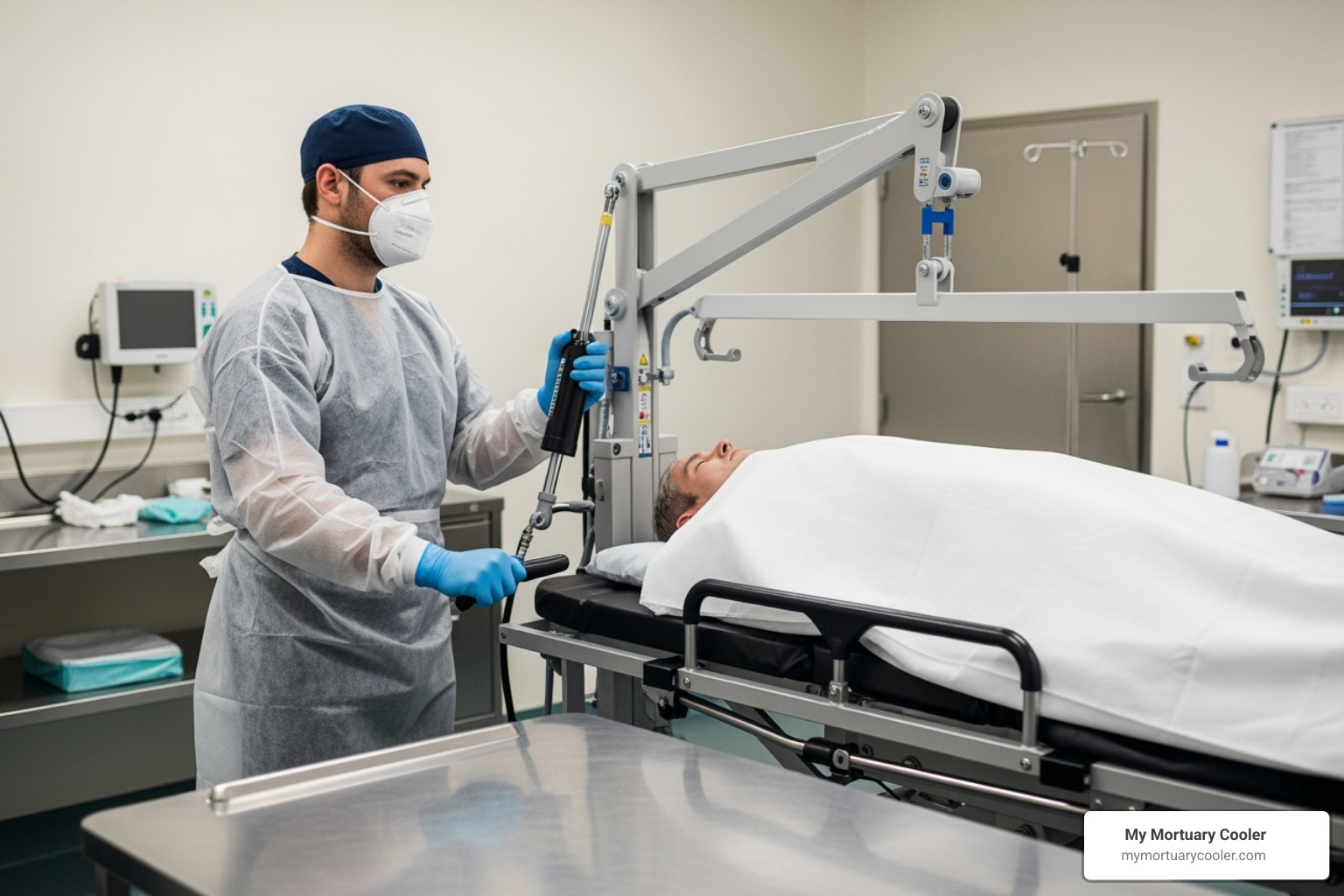
Conclusion
As we reach the end of our journey through hydraulic body lifts, it's clear these remarkable machines are so much more than just equipment sitting in a corner. They represent a fundamental shift toward safer, more dignified, and more efficient death care practices.
Think about it: every day, funeral professionals face the challenge of moving and transferring remains with the respect they deserve while protecting their own physical wellbeing. Hydraulic body lifts solve this challenge beautifully. Through the neat principles of Pascal's Law and fluid mechanics, these lifts transform a simple pump of a lever into the power to safely handle over 1000 pounds.
The benefits speak for themselves. Staff injuries drop dramatically when manual lifting is eliminated. Workflow becomes smoother and more efficient. OSHA compliance becomes achievable rather than aspirational. Most importantly, every transfer maintains the dignity that families expect and deserve during their most difficult moments.
Whether you're running a busy funeral home, managing a crematory, or overseeing operations at a medical facility, these lifts have proven themselves indispensable. Their superior lifting power, smooth operation, and independence from batteries or power outlets make them reliable partners you can count on, day after day.
At My Mortuary Cooler, we've built our reputation as America's trusted authority in mortuary equipment by understanding exactly what you need. We know the weight of responsibility you carry - literally and figuratively. That's why we're committed to providing professional-grade hydraulic body lifts that meet the highest standards of safety, durability, and performance.
The right equipment doesn't just make your job easier; it makes it possible to provide the level of care that defines exceptional death care service. When you invest in quality hydraulic lifting solutions, you're investing in your team's safety, your operational efficiency, and your ability to serve families with the dignity they deserve.
Ready to see how the right lift can transform your operations? Explore our complete range of mortuary lifts and find why funeral professionals across America trust My Mortuary Cooler for their most critical equipment needs.
















